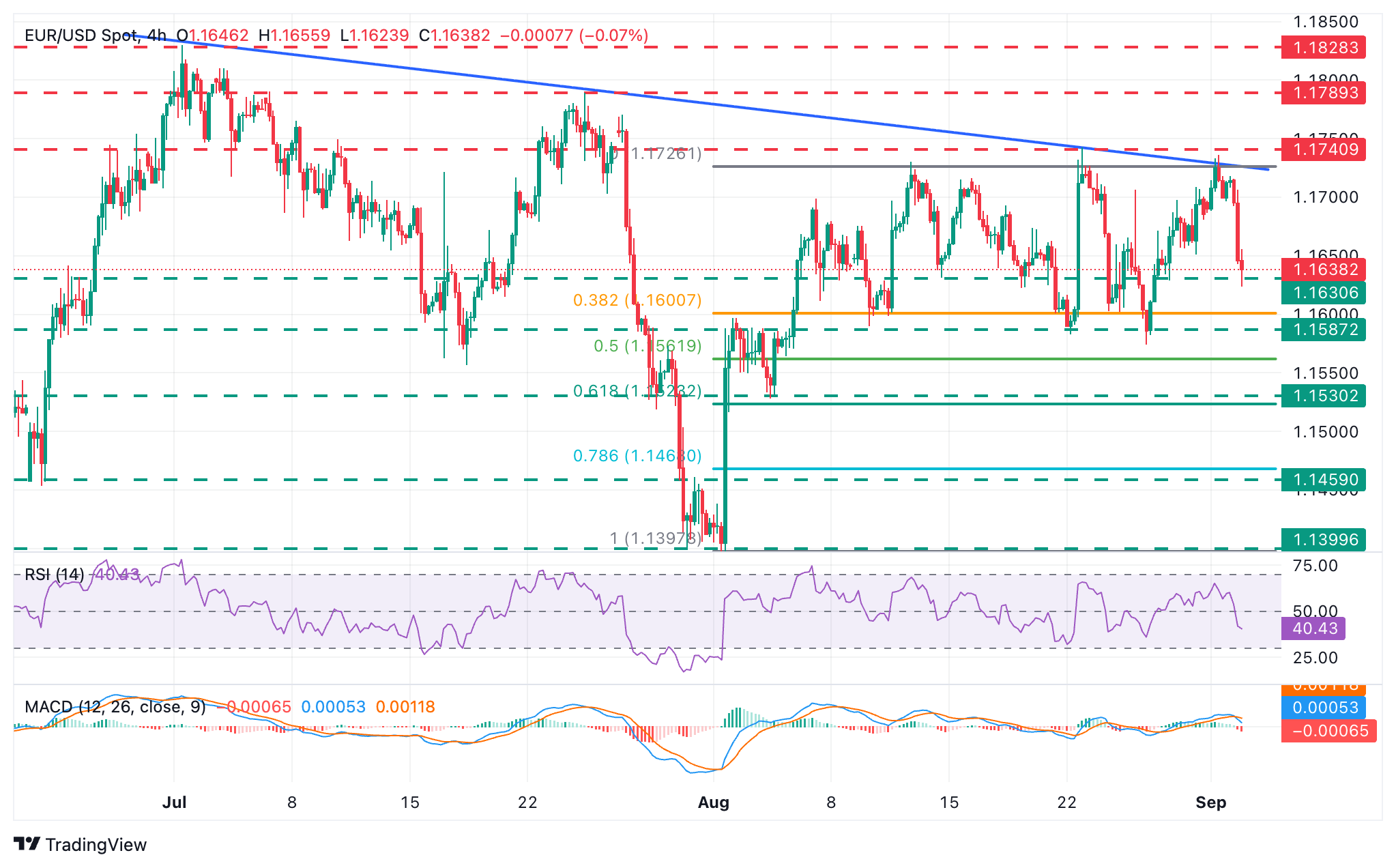Created
: 2025.09.03














![]() 2025.09.03 16:17
2025.09.03 16:17
The EUR/USD pair is heading south for the second consecutive day on Wednesday, trading at 1.1620 at the time of writing. Renewed concerns about the increasing fiscal deficits in major economies have triggered a sell-off in bond markets, steepening yield curves, and driving investors towards safe assets like the US Dollar and Gold.
The German 30-year yield has risen 10 basis points over the last three days, while French long-term yields rose to 4.50%, their highest level since 2009, after having rallied sharply in August amid the country's uncertain political outlook.
The US Dollar thrived in risk-averse markets, unfazed by the disappointing US ISM Manufacturing Purchasing Managers Index (PMI) data, which revealed that the sector's activity contracted for the sixth consecutive month in August.
Market sentiment remains sour on Wednesday, although risk aversion seems to have eased somewhat. In Europe, August's HCOB Services PMI due later will be the main data point, while in the US, Factory Orders and JOLTS Job Openings will provide the fundamental guidance for the US Dollar.
The table below shows the percentage change of Euro (EUR) against listed major currencies today. Euro was the strongest against the Japanese Yen.
| USD | EUR | GBP | JPY | CAD | AUD | NZD | CHF | |
|---|---|---|---|---|---|---|---|---|
| USD | 0.09% | 0.20% | 0.19% | 0.11% | 0.11% | 0.18% | 0.10% | |
| EUR | -0.09% | 0.12% | 0.14% | 0.01% | -0.12% | 0.09% | 0.00% | |
| GBP | -0.20% | -0.12% | -0.02% | -0.09% | -0.23% | -0.02% | -0.11% | |
| JPY | -0.19% | -0.14% | 0.02% | -0.09% | -0.17% | -0.10% | -0.08% | |
| CAD | -0.11% | -0.01% | 0.09% | 0.09% | -0.09% | 0.07% | -0.02% | |
| AUD | -0.11% | 0.12% | 0.23% | 0.17% | 0.09% | 0.04% | 0.12% | |
| NZD | -0.18% | -0.09% | 0.02% | 0.10% | -0.07% | -0.04% | -0.09% | |
| CHF | -0.10% | 0.00% | 0.11% | 0.08% | 0.02% | -0.12% | 0.09% |
The heat map shows percentage changes of major currencies against each other. The base currency is picked from the left column, while the quote currency is picked from the top row. For example, if you pick the Euro from the left column and move along the horizontal line to the US Dollar, the percentage change displayed in the box will represent EUR (base)/USD (quote).

EUR/USD came under pressure after its rejection at 1.1740 on Monday. Looking from a wider perspective, however, the pair remains looking for direction within the broadly 150-pip range that has contained price action for most of August.
The pair seems to have found some footing at Tuesday's lows around the 1.1615 area, ahead of the bottom of the monthly range between 1.1575 and 1.1590, which capped bears on August 11, 22 and 27. Further down, the 50% Fibonacci retracement level of the early August bullish run, at 1.1560, might provide some support ahead of the August 5 low, near 1.1530.
To the upside, the intraday level of 1.1680 might offer some resistance ahead of the confluence between the descending trendline resistance, now around 1.1730 and 1.1740, which encompasses the peaks of August 13 and 22, and the September 1 high, is likely to pose a serious challenge for bulls.
In the world of financial jargon the two widely used terms "risk-on" and "risk off'' refer to the level of risk that investors are willing to stomach during the period referenced. In a "risk-on" market, investors are optimistic about the future and more willing to buy risky assets. In a "risk-off" market investors start to 'play it safe' because they are worried about the future, and therefore buy less risky assets that are more certain of bringing a return, even if it is relatively modest.
Typically, during periods of "risk-on", stock markets will rise, most commodities - except Gold - will also gain in value, since they benefit from a positive growth outlook. The currencies of nations that are heavy commodity exporters strengthen because of increased demand, and Cryptocurrencies rise. In a "risk-off" market, Bonds go up - especially major government Bonds - Gold shines, and safe-haven currencies such as the Japanese Yen, Swiss Franc and US Dollar all benefit.
The Australian Dollar (AUD), the Canadian Dollar (CAD), the New Zealand Dollar (NZD) and minor FX like the Ruble (RUB) and the South African Rand (ZAR), all tend to rise in markets that are "risk-on". This is because the economies of these currencies are heavily reliant on commodity exports for growth, and commodities tend to rise in price during risk-on periods. This is because investors foresee greater demand for raw materials in the future due to heightened economic activity.
The major currencies that tend to rise during periods of "risk-off" are the US Dollar (USD), the Japanese Yen (JPY) and the Swiss Franc (CHF). The US Dollar, because it is the world's reserve currency, and because in times of crisis investors buy US government debt, which is seen as safe because the largest economy in the world is unlikely to default. The Yen, from increased demand for Japanese government bonds, because a high proportion are held by domestic investors who are unlikely to dump them - even in a crisis. The Swiss Franc, because strict Swiss banking laws offer investors enhanced capital protection.
![]()
Created
: 2025.09.03
![]()
Last updated
: 2025.09.03

FXStreet is a forex information website, delivering market analysis and news articles 24/7.
It features a number of articles contributed by well-known analysts, in addition to the ones by its editorial team.
Founded in 2000 by Francesc Riverola, a Spanish economist, it has grown to become a world-renowned information website.
We hope you find this article useful. Any comments or suggestions will be greatly appreciated.
We are also looking for writers with extensive experience in forex and crypto to join us.
please contact us at [email protected].
Disclaimer:
All information and content provided on this website is provided for informational purposes only and is not intended to solicit any investment. Although all efforts are made in order to ensure that the information is correct, no guarantee is provided for the accuracy of any content on this website. Any decision made shall be the responsibility of the investor and Myforex does not take any responsibility whatsoever regarding the use of any information provided herein.
The content provided on this website belongs to Myforex and, where stated, the relevant licensors. All rights are reserved by Myforex and the relevant licensors, and no content of this website, whether in full or in part, shall be copied or displayed elsewhere without the explicit written permission of the relevant copyright holder. If you wish to use any part of the content provided on this website, please ensure that you contact Myforex.
Myforex uses cookies to improve the convenience and functionality of this website. This website may include cookies not only by us but also by third parties (advertisers, log analysts, etc.) for the purpose of tracking the activities of users. Cookie policy